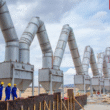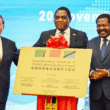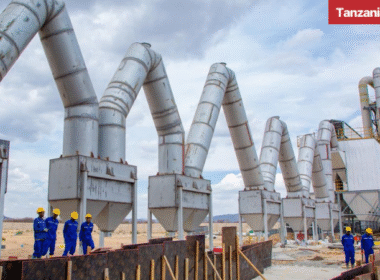Nickel
The mining of nickel in Tanzania is still in its infancy. However, the Kabanga Nickel Sulfide Deposit is one of the largest and richest undeveloped nickel sulfide deposits known at present, of unmatched scale and grade.
History of Nickel Exploration in Tanzania
Investigation throughout Africa by the International Nickel Company (INCO) in the 1950s resulted in the discovery of copper-nickel alloys (Cu-Ni) at the Kapalagulu Complex in western Tanzania and Ntaka Hill in south-eastern Tanzania.
Further investigations at Kapalagulu were carried out by Anglo-American Corporation and other organizations until the early 1970s, resulting in the discovery of lateritic nickel.
Mineral exploration was accelerated throughout the 1970s and 1980s throughout Africa, with the direct aid of the United Nations Development Programme (UNDP). Among the major discoveries was the Kabanga nickel sulfide deposit of northwest Tanzania in 1978 (part of the East African Nickel Belt-EANB).
The Kapalagulu Intrusion
Commercial exploration of the Kapalagulu intrusion commenced in the 1950s, and continues today, with several encouraging prospects having been discovered.
Nickel mineralization of both laterite (nickel associated with cobalt) and sulfide (nickel associated with copper and platinum-group elements)-the two main types of nickel deposit currently exploited at a global scale-are known from the Kapalagulu intrusion.
The East African Nickel Belt (EANB)
The major component of the EANB is located in Burundi and western Tanzania. These deposits have been explored and delineated by mining companies, but they remain undeveloped due to their distance to the Indian Ocean coast and a lack of transport and energy infrastructure.
Subsequent commercial exploration in the belt since 1990 has followed up on the UNDP discoveries. The nickel deposits of the belt are of both lateritic and sulphidic types.
Kabanga Nickel Sulfide Deposit
Kabanga is currently the only one of these EANB intrusions with potentially economic nickel sulfides.
Located in far north-western Tanzania, approximately 120 km south-west of Lake Victoria and within a few kilometers of the Burundi border, the Kabanga deposit is acknowledged to be one of the largest and richest undeveloped nickel sulfide deposits known at present, of unmatched scale and grade.
Commercial exploration has been carried out almost continuously since 1991 by various foreign mining and exploration companies.
Both the tonnage and the grade estimates of the mineral resources have increased dramatically since the first resource estimate on the Kabanga main body which was carried out by the UNDP in 1979 (21 Mt grading 1.0% Ni: United Nations Development Program, 1980). The Kabanga sulfide deposit latest Resource Estimate (Measured, Indicated, and Inferred) of 2014 indicates 58 million tonnes of ore at an average in-situ nickel grade of 2.62%. Mineralization of the resource is greater than 95% massive sulfide.
This makes Kabanga valuable because it has both a sufficient tonnage (>50 Mt) to warrant the necessary capital expenditure and a high nickel grade (2.6%) that would ensure low mining, milling, and concentration costs, relative to the value of the concentrate product.
The high grade at Kabanga is due to a combination of the high abundance of sulfide in the rock (75 to 100 modal %) and the relatively high tenor of these sulfides (2 to 4% in 100% sulfides). Neither of these features is common in the other intrusions.
Kabanga Development Potential
The large sulfide deposit at Kabanga has yet been developed and has been consistently postponed because of inadequate infrastructure. Other negative factors weighing against the early development of the deposit has been the negative public perception of large-scale foreign-owned mining operations in Tanzania, the lack of trained and experienced managers and operators for large, mechanized open-pit or underground mining operations, and the commercial uncertainty in the global nickel market, posed by the rise in production of relatively cheap nickel pig-iron in China since 2007. The extension of the Central corridor route from the existing railhead at Isaka in Tanzania, to Kigali and Gitega, is crucial in this regard.
In January 2021, the Ministry of Minerals of Tanzania signed an investment agreement with Kabanga Nickel Limited of the UK (formerly LZ Nickel Limited) for the development of the nickel mining project.
The Government of Tanzania and Kabanga Nickel have agreed to form a joint-venture, Tembo Nickel Corporation, which will own two subsidiaries: Tembo Nickel Mining Company which will be involved in Nickel mining in Kabanga, and Tembo Nickel Refinery Company which will be involved in mineral refining in Kahama, Shinyanga.
As per the new mining laws, Tanzania enjoys a 16% free-carried interest (equity interest granted to the State by the company holding a mining license), and 50/50 sharing in the economic benefits generated by the mining operations (after the recoupment of capital investments.)
In January 2022, world-leading resources company BHP has announced it will invest up to USD 100 million to accelerate the development of the Kabanga Nickel Project.
In parallel, it will invest in Lifezone Limited to advance the roll-out of its patented hydrometallurgical technology to ensure that Class 1 battery-grade nickel, copper, and cobalt will be produced in Tanzania.
The Kabulwanyele Nickel Project (KNP)
The KNP nickel project is located approximately 35km from the western shore of Lake Tanganyika. The area is part of the western limb of East African Rift systems.
Laterite hills at Kabulwanyele are prospective for nickel, cobalt, and manganese.
In April 2021, Resource Mining (ASX:RMI) announced that it has commenced exploration field activities at Kabulwanyele.
Last Updated: 17th January 2022
Sources: Kabanga Nickel, Barrick Gold, Glencore, Harmony, Resource Mining, Tanzania Ministry of Minerals, An overview of nickel mineralization in Africa with emphasis on the Mesoproterozoic East African Nickel Belt (EANB).












